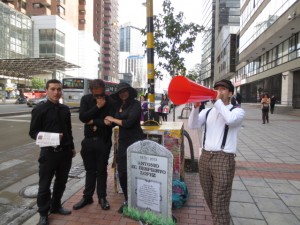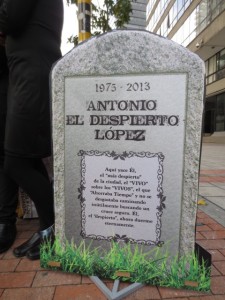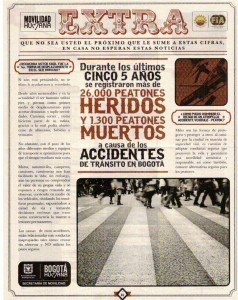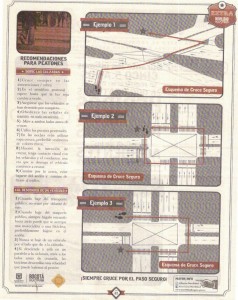 During the past few weeks as I’ve circulated around the city, I’ve noticed some unusual characters hanging around intersections and sidewalks. I saw several people dressed in zebra costumes on the Avenida Séptima near Avenida Chile (Calle 72). They were talking to pedestrians and cyclists crossing the streets in the middle of the block in front of cars, encouraging them to cross at the “cebras” (“zebras”), or crosswalks at signalled intersections. They are called cebras because they consist of white painted lines which over black asphalt look like zebra stripes.
During the past few weeks as I’ve circulated around the city, I’ve noticed some unusual characters hanging around intersections and sidewalks. I saw several people dressed in zebra costumes on the Avenida Séptima near Avenida Chile (Calle 72). They were talking to pedestrians and cyclists crossing the streets in the middle of the block in front of cars, encouraging them to cross at the “cebras” (“zebras”), or crosswalks at signalled intersections. They are called cebras because they consist of white painted lines which over black asphalt look like zebra stripes.
Then over several days and in various parts of the city, I ran into these somber characters, several dressed for a funeral and a fellow with a megaphone yelling at people to cross at the cebras. Standing next to them was a gravestone. Here’s one up close:

It says “Antonio ‘The Lively One’ López. Here he lies, the most “watchful” one in the city, the one who was aware above all the other lively ones, he who ‘saved time’ and did not wear himself out looking for a secure crossing. He, the “lively one” now sleeps eternally.” There’s some fun play on words in it; the English translation doesn’t necessarily capture it.
They also handed out flyers like this, announcing in the last five years 26,000 pedestrian injuries and 1,300 deaths due to traffic accidents:
The facts are sobering. As a recent article in El Espectador explains, one pedestrian dies per day in Bogotá, and pedestrians (one of the largest mode shares in this city) are more likely than any other street users–bus riders, cyclists, or car drivers–to get hurt or killed when there is a traffic accident. Often they are innocent victims of careening cars or buses; but as the communications above indicate, pedestrians themselves are often at fault when they run in front of cars and don’t cross at the zebras and other secure crossings.
These “intersection actions” (as we might call them in the U.S.) are part of a city-wide campaign, put on by the Secretariat of Mobility, intended to promote safety and improved traffic flow. They are a long-standing phenomenon in Bogotá. The most legendary ones were performed during the mayorships of Antanas (“El Súper Cívico”) Mockus (1995-8; 2001-3). Among others: issuing soccer red cards to drivers and pedestrians to get citizens to pass judgement on the traffic infringements of others; firing the traffic police and replacing them with mimes for a few months to shock (and embarrass) people into following traffic rules; and painting black stars on the pavement where a pedestrian was killed.
These innovative initiatives were framed as cultivating “citizen culture,” that is, producing a citizenry that recognizes and follows laws as well as norms of basic courtesy and respect for others in public space–none of which (it is widely believed) many Bogotanos are inclined to do. (See here for a video of Mockus at lecturing at Vanderbilt about the theme.) And they worked…for a time. Since Mockus, city administrations have not prioritized these issues and some of the chaos and danger has, according to many, returned. Hence, the Secretariat of Mobility has revived such intersection actions in hopes of reversing the tide and reinvigorating what they now call “inteligencia vial,” or traffic intelligence, on Bogotá’s streets to improve one of the central problems of the city.
But there’s something else going on here that needs to be said. If you turn over the flyer and see the “Recommendations for Pedestrians,” you can see very clearly a central logic of transportation planning in this city that, one could argue, puts pedestrians and cyclists in a position of either inconvenience or vulnerability vis-a-vis motorized vehicles, whose flow is clearly prioritized over others. Look at “Ejemplo 3” at the bottom, which asks pedestrians to make three crossings, instead of making one direct crossing so as not to inconvenience drivers.
What pedestrian is actually going to do this? I actually put this question to one of the people running the intersection action, and I can’t say I got a satisfying response from a pedestrian point of view: “If we can reach even several people to change their behavior, that’s important.”
A striking coincidence is that the very same day I received this flyer, there was an article in the free public newspaper ADN arguing that the focus in the city needs to shift from making pedestrians solely responsible for their own safety (such as the campaign above does) to urban transportation planners whose poorly designed infrastructure produces high rates of accidentality for pedestrians. It is because they planned and built pedestrian bridges that in certain areas people avoid, not just because they are a pain to climb up and down but also because they are easy places to get robbed. Or they designed intersections and painted cebras in places that might be convenient for the flow of motorized traffic, but not for pedestrians. Both produce in pedestrians a tendency to make shorter and more direct crossings in places that are ultimately more dangerous for them.

